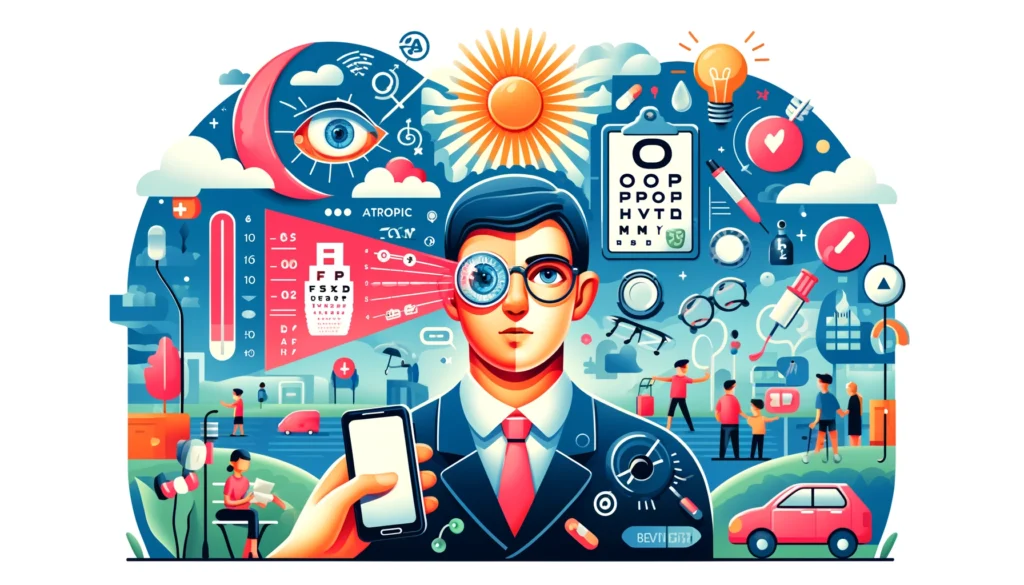
What is Myopia?
Myopia, commonly known as nearsightedness, is a refractive error where distant objects appear blurry while close objects are seen clearly. This condition arises when the eyeball is too long or the cornea has excessive curvature, causing light entering the eye to focus in front of the retina instead of directly on it. Myopia is a prevalent condition globally, affecting millions of people across all age groups, with increasing incidence rates among children and adolescents.
The increase in myopia has become a significant global public health concern, often referred to as the myopia epidemic. Several factors contribute to this rising prevalence, which can be broadly categorized into genetic and environmental influences.
Here’s an overview of the main causes:
1. Genetic Predisposition
Genetics play a crucial role in the development of myopia. Children with myopic parents are at a higher risk of developing the condition. However, genetics alone cannot explain the rapid increase in myopia prevalence over recent decades, suggesting that environmental factors are also critical.
2. Increased Near Work Activities
One of the most significant environmental factors is the increase in near work activities, such as reading, writing, and using digital devices. Prolonged periods of focusing on close objects can lead to eye strain and may contribute to the elongation of the eyeball, which is characteristic of myopia. The widespread use of smartphones, tablets, and computers has intensified this effect, especially among children and adolescents.
3. Reduced Time Spent Outdoors
Several studies have shown that spending less time outdoors is associated with a higher risk of developing myopia. Exposure to natural light and the opportunity to focus on distant objects are thought to be protective factors. Outdoor activities encourage the eyes to relax and reduce the strain associated with prolonged near work. The shift towards indoor lifestyles, often driven by educational demands and urban living, limits these beneficial exposures.
4. Educational Pressures
Children are spending more time studying and engaging in near work at the expense of outdoor play. The competitive academic environment in countries like China, South Korea, and Japan exacerbates this issue, leading to higher myopia rates among students.
5. Urbanization
Urbanization is linked to lifestyle changes that increase the risk of myopia. In urban settings, children tend to spend more time indoors and have less access to open spaces for outdoor activities. Additionally, urban environments often have higher levels of near work activities and screen time compared to rural areas.
6. Insufficient Lighting
Poor lighting conditions during near work activities can strain the eyes and contribute to myopia development. Ensuring adequate and appropriate lighting when reading or using digital devices is essential to minimize eye strain and prevent the progression of myopia.
7. Diet and Health Factors
Although less well-established, some research suggests that diet and overall health might influence myopia risk. For example, insufficient intake of essential nutrients during childhood could potentially impact eye development.
Raising awareness about myopia is crucial for early detection and management. Uncorrected myopia can significantly impair daily activities such as driving, reading, and using digital devices, leading to reduced quality of life. Moreover, high myopia can increase the risk of serious eye conditions like retinal detachment, glaucoma, and cataracts. By promoting regular eye examinations and understanding the signs of myopia, individuals can seek timely intervention to prevent further complications.
Latest Developments in Myopia Management
Recent advancements in optometry have led to innovative strategies for managing myopia, particularly in children. Here are some of the latest updates:
- Orthokeratology (Ortho-K): This non-surgical method involves wearing specially designed contact lenses overnight to reshape the cornea temporarily. Ortho-K lenses correct vision during the day and have shown promise in slowing the progression of myopia in children.
- Atropine Eye Drops: Low-dose atropine eye drops have emerged as an effective treatment for slowing myopia progression. Studies have demonstrated that atropine can significantly reduce the rate of eye elongation in children, thereby controlling myopia advancement.
- Multifocal Contact Lenses: Designed with multiple focal points, these lenses provide clear vision at various distances and have been found to slow myopia progression. Multifocal contact lenses are particularly beneficial for children who are not ideal candidates for Ortho-K or atropine treatments.
- Lifestyle Modifications: Encouraging outdoor activities and reducing screen time are simple yet effective strategies to mitigate nearsightedness risk. Exposure to natural light has been shown to have a protective effect against myopia development in children.
The myopia epidemic is driven by a complex interplay of genetic predispositions and environmental factors. Increasing awareness of these causes and implementing preventive measures, such as encouraging outdoor activities, managing near work habits, and ensuring proper lighting, can help mitigate the rising prevalence of myopia. Public health initiatives and educational reforms are also crucial in addressing this growing concern of nearsightedness.
Awareness and proactive management are key to addressing the myopia epidemic. With the latest advancements in treatment options and a focus on preventive measures, optometrists can offer effective solutions to manage and control myopia, improving the quality of life for individuals affected by this condition. Regular eye check-ups, combined with informed choices about myopia management, can lead to better visual health outcomes for all.
#MyopiaAwareness#Nearsightedness#EyeHealth#VisionCare#MyopiaPrevention#ChildEyeCare
#DigitalEyeStrain#Orthokeratology#AtropineDrops#OutdoorVision